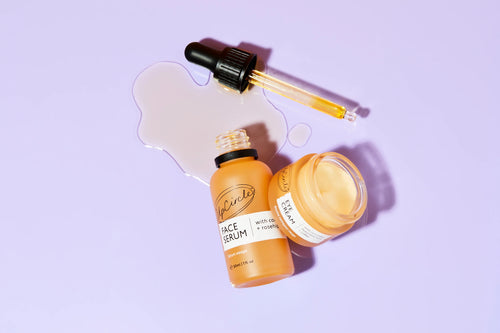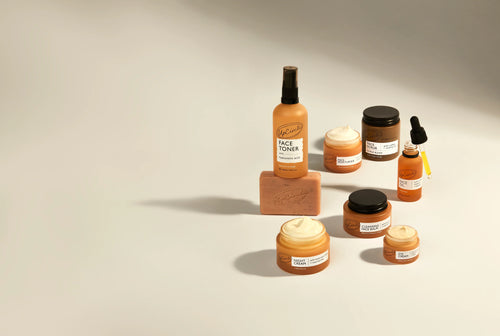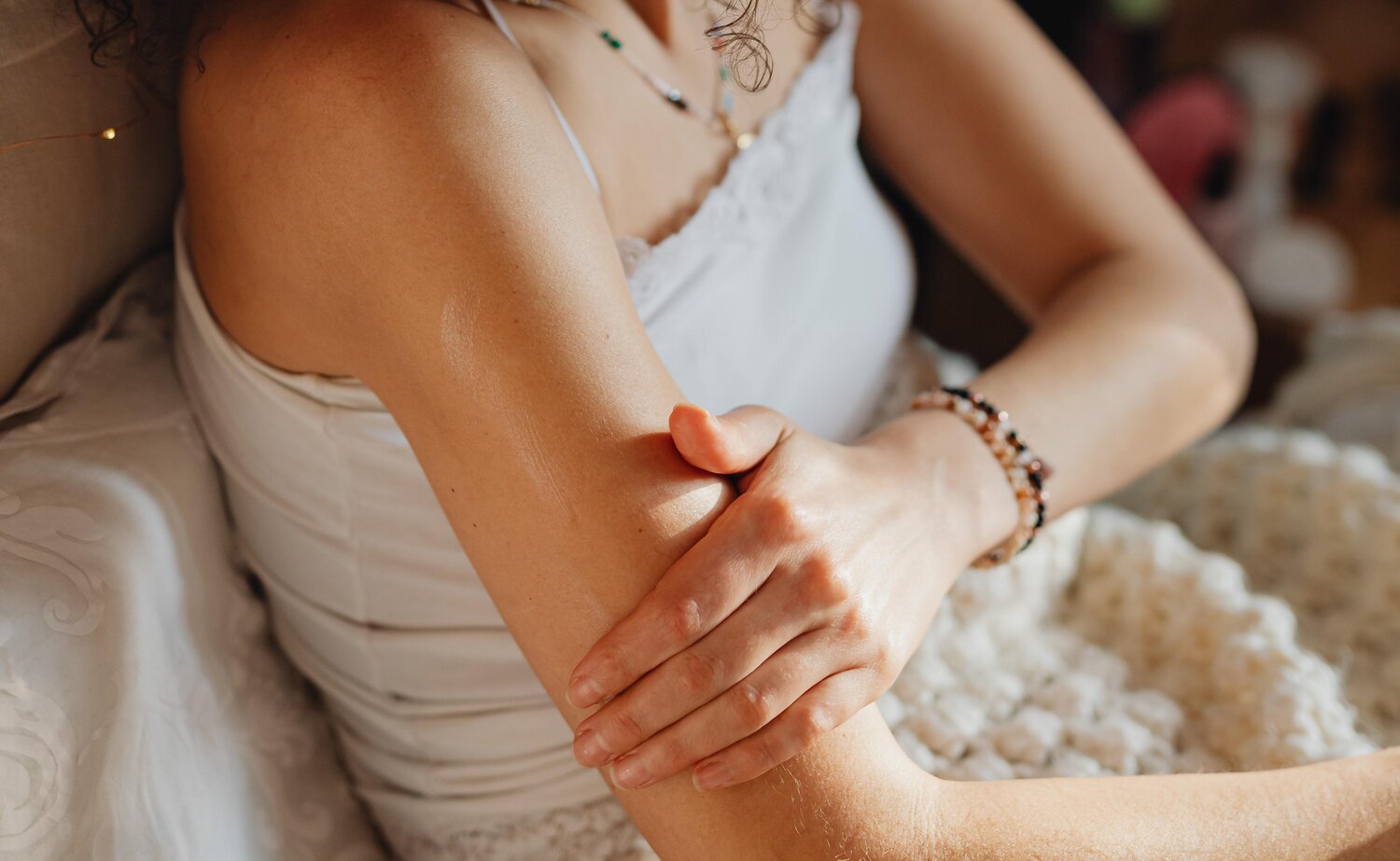Keratosis pilaris is perhaps the most common form of bumpy skin and is sometimes referred to as chicken skin, because of its appearance. We can all feel a little self-conscious when our skin isn’t behaving as we hope it would. So here we take you through everything you need to know about keratosis pilaris, including what it is and the best products for keratosis pilaris.
Just remember though, all skin is wonderful skin. Your skin plays such an important role in your health and wellbeing – and it does a great job too! Always be kind to your skin, and yourself.
What is keratosis pilaris?
Absolutely harmless, keratosis pilaris is a common skin condition. You’ll almost certainly have seen it before but may not have known its name. It’s characterized by tiny pinprick bumps on the skin, usually on the upper arms, thighs and bottom. Some people also get it on their cheeks. The bumps are typically red in color and dry, but they don’t usually itch or hurt.
Keratosis pilaris causes
The causes of keratosis pilaris aren’t entirely clear cut. With keratosis pilaris, there is a build-up of keratin in the skin. This is a hard protein that is perfectly normal within the skin. But too much can block the hair follicles, leading to keratosis pilaris.
We do know that it tends to be worse when the weather is drier and there is less humidity. We also know that it’s worse for those with dry skin.
It’s far more common in younger people and often resolves of its own accord by the time you’re in your thirties.
If you’re wondering what causes keratosis pilaris to flare up, it may be that you have some unique triggers. Try to keep a record of what you’re eating, what you’re doing, the weather and your stress levels. This may help you discover your own keratosis pilaris causes. It can also be associated with atopic dermatitis.
Keratosis pilaris treatment
Keratosis pilaris treatment isn’t usually necessary, as it tends to clear up of its own accord. However, if you dislike what it looks like, patience can be difficult!
The good news is there are lots of things you can do at home to help reduce the appearance of keratosis pilaris.
How to get rid of keratosis pilaris
Moisturize
The number one thing you can do is moisturize regularly and effectively. Our Natural Body Cream with Date Seeds delivers a hit of hydration that gets locked in. Use this twice daily. If you have keratosis pilaris on your face, we recommend our Face Moisturizer with Vitamin E.
Salicylic acid for keratosis pilaris is believed to help because it gently exfoliates, and you’ll find this in our moisturizer. The best cream for keratosis pilaris is one which is highly hydrating but also non-comedogenic, meaning it won’t further block the pores.
For this reason, many people also try coconut oil for keratosis pilaris. You’ll need to experiment to see if this works for you.
Exfoliating
Exfoliating can improve the appearance of the skin, but it needs to be gentle. Salicylic acid can help to gently exfoliate the skin. For the body, an exfoliating body wash can really help for keratosis pilaris.
Use a gentle body scrub, such as our Coffee Body Scrub with Lemongrass. Remember to be gentle though. Avoid harsh soaps or shower gels, as these can make it worse. For washing, use a gentle cleanser, such as our Chai Fennel + Cardamom Soap Bar.
Take care in the shower
Keep your shower or bath quite cool as the higher temperature strips important oils from your skin, making it drier. Keep your shower short and sweet. When you get out, rather than scrub with a towel, gently pat the skin to help to reduce the redness. Then slather on the moisturizer.
If you choose to shave, you need to take care when shaving. Shaving can worsen keratosis pilaris, as can waxing, so minimize how often you choose to shave affected areas.
Increase humidity
While too long in the shower won’t be helpful, the humidity from a shower might be. It seems that many people find keratosis pilaris gets worse in winter when it’s drier and less humid.
Instead, you could use a humidifier. To do this and get the benefits, place a bowl of water by your radiators, or simply run a hot shower for a while nearby.
Wear loose clothing
Irritation can occur if you wear tight clothes. Wear loose fitting clothes for comfort and to protect any affected skin.
Don’t scratch or pick
If your skin is itchy, it’s likely the dryness causing this – so get moisturizing! However, don’t try to scratch or pick the pinprick bumps. They aren’t spots (which you should definitely not pick anyway) and can lead to scarring if you pick them. If you’re wondering how to fade keratosis pilaris scars, choose a retinoid. It’s another reason why our Natural Body Cream with Date Seeds is great – it’s rich in vitamin E.
Be patient
We know that you may find your keratosis pilaris unsightly, but it will fade. It’s tempting to jump on bandwagons, such as a special keratosis pilaris diet. While we always recommend a healthy diet rich in green veg and antioxidants for healthy skin, there’s little evidence to show that keratosis pilaris is linked to diet.
Although there is anecdotal evidence that some people have found reducing gluten, lactose or spices has helped, the solid evidence just isn’t there. If you think your diet may be making it worse, keep a diary and see if you can spot patterns. Do, however, try to be patient and lower stress levels. If you do choose to make any dietary changes, always check in with a medical professional first.
Further keratosis pilaris treatments
The best products for keratosis pilaris are highly hydrating and also help to remove dead skin cells, such as those containing salicylic acid. Your GP or dermatologist may also be able to prescribe stronger treatments and creams if your condition is particularly troublesome.
Some people also find that light or laser treatment for keratosis pilaris can help. Laser hair removal seems to be particularly effective as it stops the follicle getting blocked with a build-up of keratin. It will likely take multiple sessions to help and can be very expensive, especially for a condition that clears up with home remedies and patience.
All of the UpCircle products are natural and formulated carefully to help with skin conditions like keratosis pilaris, so you can rest assured that your skin is being taken care of by natural ingredients.






